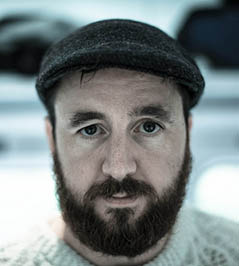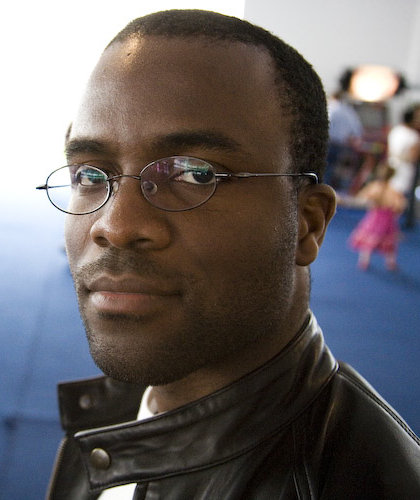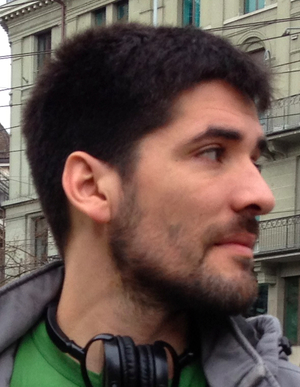
Eamon Leonard
Eamon Leonard is an advisor to start-ups, an angel investor, a tech community organiser and has an interest in cloud platforms and developer tools. Based in Ireland, he is VP of Engineering at Engine Yard, having joined the company through their acquisition of Orchestra, a PHP Platform-as-a-Service, which he co-founded in 2011.
Opening Keynote

Josh Holmes
Josh Holmes is a passionate soul who gets his kicks solving problems with deep fried awesomeness. He is currently employed by Microsoft Ireland as an Architect Evangelist. Prior to joining Microsoft in October 2006, Josh was a consultant working with a variety of clients ranging from large Fortune 500 firms to smaller sized companies.
Closing Keynote

Linda Sandvik
Linda is a interface developer, wannabe MacGyver and adventurer. She's a nomad but is currently living in Hackney (London) and learning UX design at Last.fm (she likes learning new things).
She is a technology resident at Spike Island art gallery, and recently discovered tinkering with electronics. She has made stuff like a laser harp, burping trashcans and an arcade style cycling game with actual bicycles as the controllers. She is obsessed with facilitating creativity & learning, and making interactive installations that bridges the physical and digital.
Making things better
How do we become better interface developers? How do we find better problems to solve?
The most interesting work lies outside of your comfort zone. So how can you get there? This is a sort of crash course in stepping out of your comfort zone, trying new things, learning to learn and creating your own luck.
How should we do research & development? To be innovative, we must create a culture that tolerates failure. But who wants to fail? And certainly not admit to it. I want to share with you some of my failures. We're taught to do things the right way. But to discover something that other people haven't, one needs to do things the wrong way.

Ian Barber
Ian Barber works as a Senior Developer Advocate for Google+, and is based in Google's London office. Ian has been developing and managing development teams professionally since 2002. Among various open source interests, Ian is the author of the PHP Support Vector Machine extension and a contributor to the brokerless messaging library ZeroMQ. He blogs at http://phpir.com and http://www.riskcompletefailure.com.
How Google Builds Webservices
We've been building web services for many years at Google, and over the years our approach to them has evolved. In this talk we will look at some of the lessons learned and how they are embodied in the latest generation of our API service, and why developer experience matters both outside and inside of a team. This talk should be helpful for anyone considering or developing web services for the wider development community.

Ross Tuck
Ross Tuck is a senior developer and team lead at Ibuildings in the Netherlands, despite being American. He's currently obsessed with hypermedia, CQRS and vector graphics but this tends to change quickly. Otherwise, he's usually trying to make time to read.
HTTP and Your Angry Dog
What is an etag, exactly? What's all that stuff in the Accept header? And what the heck does a Vary header do anyways?! Web developers use HTTP everyday but most of us don't know how to get the most out of it. This talk goes past memorizing status codes (although we'll see those too) and teaches how to get the most out of every request and response.

David Zuelke
David Zuelke works as the Lead Architect at EMH Technologies, the technical incubator of European Media Holding, in Munich, Germany. He has been developing applications on the web since long before the turn of the millennium and regularly speaks at conferences around the world about things he likes or gets to work on, such as systems architecture, REST & HTTP, Hadoop & Big Data, CouchDB and, of course, PHP.
Surviving a Prime Time TV Commercial
Setting up an online shop is a relatively trivial task these days. Pick your application, adjust some templates, sign payment provider contracts, make sure your supply chain is in order, and launch.
But once you decide to aim higher and start airing commercials, on TV, during prime time hours, then regular off-the-shelf software will not cope with the flood of incoming requests. That's when it is time to build something a little more durable, without a single point of failure, serving pages in under a hundred milliseconds, unfazed by extreme concurrency.
This is a talk about lessons learned and missions accomplished.

Ade Oshineye
Ade is a Senior Developer Advocate in Google's London office and works on the Google+ project. Over the last decade he's worked on trading systems for a variety of investment banks as well as on Google's advertising and mobile search systems. He's also the co-author of "Apprenticeship Patterns": a book that teaches you how to learn to be a great programmer. He's particularly interested in Developer Experience, distributed systems and the future of online news.
Identity, responsiveness and the future of the web
Devices like the Chromebook Pixel (which are hi-DPI, touch-sensitive but aren't phones or tablets) show us that the future of the web is too complex for a simplistic approach to responsiveness. It's not enough to think that media queries and a few screen width breakpoints suffice to make your site future-friendly.
In this talk I'm going to propose that responsiveness requires us to take into account the entire context of the user. That means everything from device orientation to bandwidth to identity.

Andy Hume
Andy is client-side architect at the Guardian in London where he works on technical strategy across a range of digital products. With a background in client-side web development he has worked as a lead engineer on Bing Maps, and as a consultant at Clearleft for clients ranging from the BBC and Channel 4 to Mozilla and Gumtree.
Anatomy of a responsive page load
With more people accessing the web on mobile devices over mobile networks, the performance of your responsive website is only becoming more important. Creating a site that appropriately loads the content and assets required to deliver a great user experience to the widest range of users is a task fraught with trade-offs and nuances. Using the Guardian's new mobile first responsive site as a case study, we'll look at how you get browsers to download content and show it on people's screens as quickly as possible.

Alan Greenblatt
Alan Greenblatt is a senior technical evangelist at Adobe. Over the years, Alan has worked on everything from 2D & 3D graphics and animation for Sun & Microsoft, Semantic Data Integration for NATO & Airbus and Web development for various financial and pharmaceutical companies. These days he focuses on Web Standards and Web & Mobile app development. Now he enjoys coding, writing & talking about all of the above. You can reach Alan on Twitter at @agreenblatt or on his blog, http://blattchat.com.
Coming Soon to a Browser Near You
Several exciting new Web standards in the areas of magazine-style layouts and advanced graphical and special effects are working their way through the W3C . Implementations of these advanced features are already starting to show up in various mobile and desktop browsers. We'll discuss the state of these technologies, and show you how and where you can use them right now and what to expect in the near future.

Lorna Mitchell
Lorna is an independent web development consultant based in Leeds, in the north of England. She is a published author, delivers training on a variety of PHP- and API-related topics, is a regular conference speaker, and works with a variety of clients on their web development and API projects. Lorna is also an active mentor with PHPWomen, helped found the PHP North West conference, and now leads the joind.in open source project.
Debugging HTTP
In this world where we have moved beyond web pages and build ever-more asynchronous applications, often things that go wrong result in errors we can't see. This session will give a very technical overview of HTTP and how to inspect your application's communications, whether on the web or on a mobile device. Using Curl, Wireshark and Charles, we can quickly and painlessly identify where the problem exists, without spending a lot of time making changes to our application to identify a problem. Whether you're debugging a backend API, an ajax request or an unexpected timeout, these are the tools you will want to have at hand.

Rowan Merewood
Rowan is a software engineer and technical team lead at Inviqa. He's worked commercially with PHP for well over 6 years, and dabbling in Python, Java, and BASIC if you go back far enough. His work has encompassed everything from tiny in-page scripts through to multi-million pound billing engines using a variety of open source technologies. Rowan is based in Sheffield, UK, makes semi-regular treks over to the PHPNW user group meetings and accidentally organises the Sheffield PHP user group.
Building Better Developers
Nothing stands still in this industry: new language features in your weapon of choice, nginx gaining ground on Apache, yet another standard you should be adhering to, cloud hosting services making deployment as easy as "git push"... the list goes on. What can you do to make sure that you're keeping up with all these changes without cloning yourself and only sleeping 3 hours a week?
It's not just about improving your coding skill, it's understanding how to make all your abilities and those of your peers work together to keep you ahead of the game. We'll look at a combination of human hacks and hard work to help fine tune the most important machine you own.

Phil Leggetter
Phil Leggetter is a Developer Evangelist at Pusher, a real-time web hosted API for quickly, easily and securely adding scalable real-time functionality to web and mobile apps . He’s been developing and using real-time web technologies for over 10 years. His focus is to help people use these technologies to build the next generation of interactive and engaging real-time web applications.
Real Time Web Apps in the Wild
It’s been possible to instantly push information from a web server to a web browser for at least 10 years, but this technology has finally gone mainstream thanks to technologies like WebSockets and solutions like socket.io, Faye, SignalR and Pusher. In this sessions I'll cover the past, present and future of client/server communication technology, the realtime web and provide a number of use cases and demonstrations of how the technology is actually used today (it's not just chat and spaceship games).

Alvaro Videla
Alvaro Videla works at VMware as Developer Advocate for Cloud Foundry. Before moving to Europe he used to work in Shanghai where he helped with building one of Germany's biggest dating websites. He co-authored the book "RabbitMQ in Action" for Manning Publishing. Some of his open source projects can be found on Github. Apart from code related stuff he likes traveling with his wife, listening/playing music and reading books. You can find him on Twitter as @old_sound.
Scaling Applications with RabbitMQ
Do you need to process thousands of images in the background for your web app? Do you need to share data across multiple applications, probably written in different languages and sitting at different servers? Your real time data feed is becoming slow because you are polling the database constantly for new data updates? Do you need to scale information processing during peek times? What about deploying new features with zero downtime? If any of these problems sound familiar then you probably need to use messaging in your application.
In this talk I will introduce RabbitMQ, a messaging and queue server that can help us tackle those problems. We will learn how to implement messaging into our applications, use Pub/Sub, RPC and give a new meaning to the term 'decoupling'.

Graeme Mathieson
Graeme was converted to Configuration Management when he joined TARDIS (the student-run computing facility at Edinburgh University) in the 90s, when it was using LCFG (Edinburgh's home grown system). By his final year at University, he shared his student bedroom with a noisy rack of Sparcstation 2s, all managed with LCFG. Since then, he's managed infrastructure with CFEngine and Chef, but is currently liking Puppet the best.
He's also a Ruby developer, and runs the Scottish Ruby Conference. You can find Graeme on Twitter as @mathie and he blogs sporadically at woss.name.
Automate All The Things!
Configuration Management (be it with Puppet, Chef, CFEngine or a pile of home grown scripts) is an essential tool for automating the management of server infrastructure. It's all well and good configuring the first server by hand, albeit a bit dull and error prone! But what happens when you hit the front page of Tech Crunch and need to increase capacity fast?
And why stop there? Having a consistent, repeatable, environment for development means your entire team are working against the same systems, reducing the disparity between development and production.
This is a practical talk. I'll take you through an example of building a virtualised development environment with Vagrant and Puppet, then I'll show you how to reuse the same Puppet configuration to spin up staging and production environments on Amazon EC2

Robert Nyman
Robert is a Technical Evangelist for Mozilla and the Editor of Mozilla Hacks, the developer blog. He's a strong believer in HTML5 and the Open Web and has been working since 1999 with Front End development for the web - in Sweden and in New York City. He also blogs at http://robertnyman.com, tweets as @robertnyman and loves to travel and meet people.
Bringing the open web and APIs to mobile devices with Firefox OS
Learn about the vision behind Firefox OS, and the open web technologies available for building HTML5 apps, including WebAPIs. Check out our Boilerplate app and other tools designed to get you started developing HTML5 apps for Firefox OS and the web.



